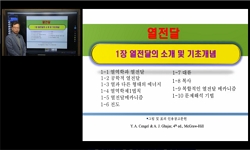본 논문은 LED Package Frame의 재질 변경으로 인한 열 특성 개선에 관한 연구로서, 현재 적용되고 있는 Leadframe 이나 LTCC(Low Temperature Co-fired Ceramics) type의 고출력 LED Package 소자가 각 Frame 재질에 따...
http://chineseinput.net/에서 pinyin(병음)방식으로 중국어를 변환할 수 있습니다.
변환된 중국어를 복사하여 사용하시면 됩니다.
- 中文 을 입력하시려면 zhongwen을 입력하시고 space를누르시면됩니다.
- 北京 을 입력하시려면 beijing을 입력하시고 space를 누르시면 됩니다.
https://www.riss.kr/link?id=T11665282
- 저자
-
발행사항
서울 : 연세대학교 공학대학원, 2009
-
학위논문사항
학위논문(석사) -- 연세대학교 공학대학원 , 전기공학전공 , 2009.2
-
발행연도
2009
-
작성언어
한국어
-
주제어
열전도도 ; 열저항 ; 고출력 LED package ; thermal conductivity ; thermal resistance ; high power LED package ; lead-frame ; LTCC ; Qfin ; T3ster
-
발행국(도시)
서울
-
기타서명
(A) study on the thermal properties of the high power LED package depending on frame materials
-
형태사항
36장 : 삽도 ; 26 cm
-
일반주기명
지도교수: 윤일구
- 소장기관
-
0
상세조회 -
0
다운로드
부가정보
국문 초록 (Abstract)
본 논문은 LED Package Frame의 재질 변경으로 인한 열 특성 개선에 관한 연구로서, 현재 적용되고 있는 Leadframe 이나 LTCC(Low Temperature Co-fired Ceramics) type의 고출력 LED Package 소자가 각 Frame 재질에 따른 방열 구조의 한계성으로 인한 높은 열 저항으로 인하여 활발한 응용이 이루어지지 않고 있는 문제점을 열전도도가 높고 가공성이 용이한 재질을 적용한 Frame을 적용함으로서 낮은 열 저항을 통한 신뢰성 확보와 제작 공정의 단순화로 저단가의 고출력 LED 소자를 널리 적용할 수 있도록 해결방안을 제시하고자 한다.본 연구에서는 열 저항 개선을 위하여 소자의 Frame 재질을 열전도도가 단가 대비 상대적으로 우수한 순수 동(Pure copper)을 적용하였으며, reflector의 형성을 위하여 다른 재질과의 부착 및 접착 층으로 인한 열 저항의 증가를 막고자 Frame 내부에 습식 식각(wet-etching) 공법을 적용하여 동일한 재질로 내부에 형성된 일체화된 reflector를 구현하였다. 또한, 실험의 조속한 진행과 시행착오를 줄이기 위하여 방열 modeling은 자동으로 격자를 생성하여 유체의 동적 움직임을 해석하는데 유용한 IcePack과 Qfin을 이용하였으며, 광기술원에 보유하고 있는 열 저항 분석장비인 T3ster(Thermal Transient Tester)를 이용하여 열 저항에 대한 객관적인 측정 data를 확보하였다.본 연구를 통하여 High Power LED Package에 적용된 각 Frame 재질별 열 특성을 비교한 결과 순수 동을 적용한 Frame을 사용한 소자가 Copper Alloy 및 Ceramic 재질을 적용한 소자에 비하여 열 저항이 각각 29.8 ℃/W, 2.29 ℃/W 정도 감소되었으며, 열 저항 감소로 인하여 chip 주위의 잔류열에 의한 chip의 손상을 최소화시켜 광 효율 또한 33.2%, 12.8% 정도 향상됨을 확인함으로서 고출력 LED 소자의 효율을 향상시킬 수 있는 또 하나의 해결방안을 제시할 수 있었다.
다국어 초록 (Multilingual Abstract)
The purpose of this study was to improve the thermal properties of the high power LED Package Frame depending on its materials. The current lead-frame or LTCC (Low Temperature Co-fired Ceramics) type high power LED Package cells are not much applied, ...
The purpose of this study was to improve the thermal properties of the high power LED Package Frame depending on its materials. The current lead-frame or LTCC (Low Temperature Co-fired Ceramics) type high power LED Package cells are not much applied, because they may cause high thermal resistance due to limited radiation structure depending on frame materials. In such circumstances, this study aimed to apply the frame made of materials with higher thermal conductivity and easier processing and thereby, suggest the ways to improve the thermal resistance and simplify processing to produce more reliable and less expensive LED cells.In order to improve the thermal resistance, this study used the 'pure cooper' relatively highly conductive but less expensive for the cell frame material, and applied the wet-etching engineering method within the frame cells to prevent the thermal resistance from increasing due to adhesion to or contact with other materials to form a reflector and thereby, formed an integrated reflector of the same material inside. In addition, in order to facilitate the test and reduce errors, IcePack and Qfin forming the grids automatically to interpret the dynamic movements of the liquid were used for the radiation modelling. Besides, T3ster (Thermal Transient Tester) or the thermal resistance tester owned by Korea Photonics Technology Institute was used to obtain some objective thermal resistance data.As a result of comparing the thermal properties among the frame materials applied to the high power LED package, it was found that when the pure copper was used, the thermal resistance decreased about 29.8 ℃/W and 2.29 ℃/W, respectively, compared with copper alloy and ceramics used, while the photonics efficiency increased about 33.2% and 12.8%, respectively, because of the minimized chip loss caused by the residual heat due to decreased thermal resistance. Thus, this study could suggest another solution to improvement of efficiency of the high power LED cells.












